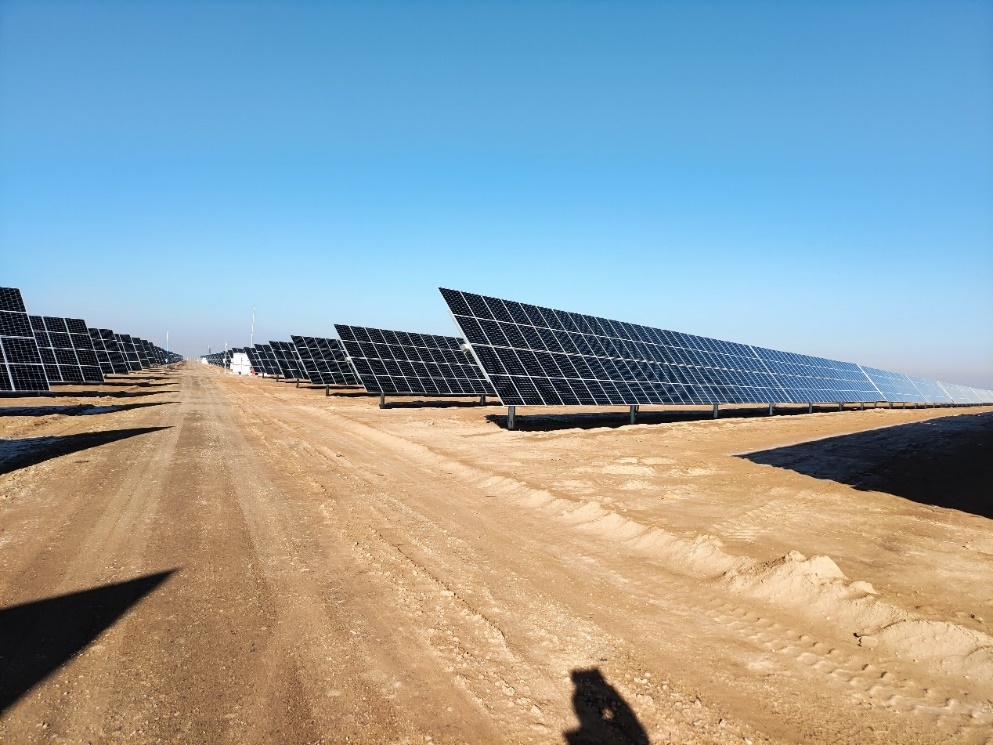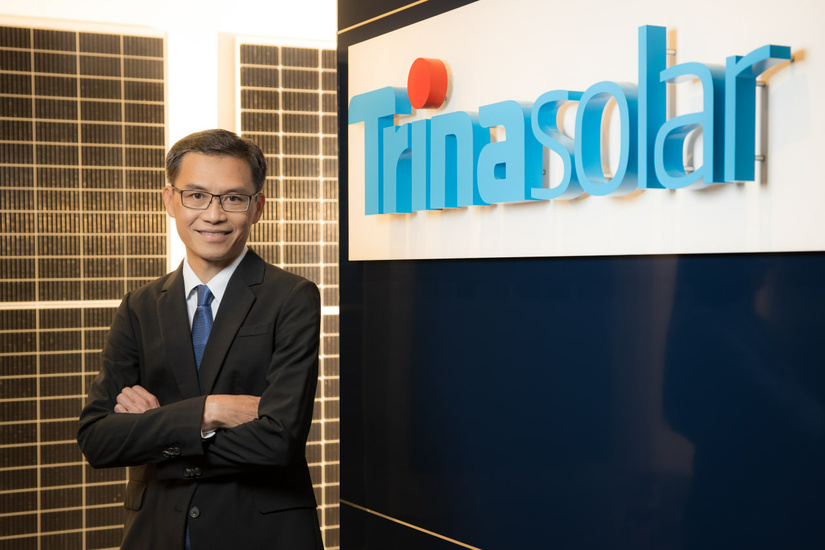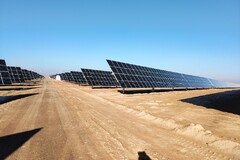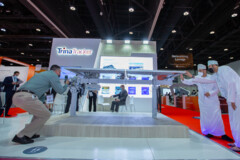— Your company is one of the world leaders in the development and production of technologies for solar power plants. Can you briefly describe your main products?
Trina Solar is mainly engaged in the research and development, production and sales of PV modules; power stations and system products; PV power generation, operation and maintenance services; development and sales of intelligent microgrids and multi-energy systems, as well as the operation of energy cloud platforms, etc. main products to be highlighted in Uzbekistani market are solar module, tracker and storage.
Our Vertex ultra-high power modules are based on the 210mm product technology platform and have become the preferred choice worldwide. By virtue of the advanced i-TOPCon (Industrial Tunnel Oxide Passivated Contact) cell technology and 210mm technology, Trina Solar has built a robust n-type ecosystem that can be applied in numerous settings, helping its customers reap great benefits. The company’s mass-produced modules power output is forecast to exceed 700W next year.
Trina Tracker develops high-tech, intelligent and tailor-made tracker solutions that when they are integrately implemented create strong synergies that lead to energy production maximization and cost reduction in a solar PV plant. Trackers are used to move the modules according to the current position of the Sun to make the most of available energy.
We also offer solutions not only for generating power but for its efficient storing. Trina Storage is ramping up battery manufacturing capacity to strengthen vertical integration, lower average cost through economies of scale as well as improve cell performance with better control over production process.
Elementa is a modular and smart storage solution, tailored for grid-scale installations in key storage markets. Fully integrated and prefabricated with state-of-the-art LFP batteries, liquid-cooled thermal management system, battery management system as well as fire detection & suppression system, it is optimized for flexibility, smooth installation, and efficient maintenance.
— It's no secret that the market for solar power equipment is highly competitive. What innovations do you use to win the trust of your customers?
Founded in 1997 by Gao Jifan, Trina Solar helped to change the industry, rapidly growing from one of the first PV enterprises in China to become one of the world leaders in solar technology and manufacturing.
As a customer-oriented company, we committed to providing high-quality products. Vertex modules, with high power, high efficiency, high reliability, high energy yield and low LCOE (Levelized Cost of Electricity), have become hugely popular around the world.
As an early mover in the field, Trina Solar has developed advanced n-type technology that has been brought into large-scale industrial application. Main advantages of it are the 210R rectangular cell, the selective boron emitter, the backside microstructure reflector, and the highly doped TOPCon structure with PECVD - these create an opportunity to deliver potential production efficiency of 26%, with module power output of up to 700W.
Other our innovations include, for example, multi-busbar technology for better light trapping effect, non-destructive cutting so that the silicon wafers are naturally separated by thermal stress without micro-cracks, high-density interconnecting which reduces the cell spacing to around 0.5mm and improves the overall efficiency of the module, etc.
— What technological innovations is the company working on today? Do you have your own know-how? How are you going to stay ahead of your competitors?
We believe achieving carbon neutrality consists of four critical elements on technology. The first is to intensify efforts to develop PV power generation, the second is to speed up the development of energy storage technology, the third is to digitize energy, and the fourth is to develop ultra-high voltage network.
To date, Trina Solar has broken 25 world records on solar cell efficiency and module power. We were the first company to receive Client Test Data Program (CTDP) certification from UL, allowing us to conduct cutting-edge research reliably on campus. The unmatched level of innovation has made us global leaders in setting industry benchmarks for both quality and efficiency.
We invest heavily in R&D: the company obtained 173 new patents in 2022 and now owns 1,161 patents, which is far ahead of competing enterprises in the Chinese PV industry.
— In 2018, Trina Solar launched the Energy IoT brand for the first time and now aims to become a global leader in smart energy. What are the prospects for smart energy for the industry and customers?
We did not only launch Energy IoT brand, but established the Trina Energy IoT Industrial Development Alliance together with leading enterprises and research institutes in China and around the world, and founded the New Energy IoT Industrial Innovation Center. With these actions, our company is committed to working with its partners to build the energy IoT ecosystem and develop an innovation platform to explore New Energy IoT, as it strives to be a leader in global intelligent energy.
Our mission is to lead the way in smart solar energy solutions for a net-zero future. We believe the new-energy and PV industries have incredibly good prospects. Although local carbon neutrality is a way off, we participants of this industry play a critical role in making it happen. We are immensely proud of the role we have played over the past 26 years in offering smart solar energy solutions to the world. We are excited about the next 26 years, including the prospect of building a user-oriented PV ecosystem. At the same time, we are sober-minded as we face the responsibility with others in the industry of creating a net-zero future for all.
Moving forward, Trina Solar will continue to work with all stakeholders to protect the biosphere, support global decarbonization initiatives, and make solar energy available to people everywhere.
— When do you think the technology limit will be reached? How much can the cost of solar panels decrease, and at what cost?
According to BloombergNEF, solar LCOE has fallen 84% over the past 10 years. The International Renewable Energy Agency forecasts that solar PV capacity will reach a total of more than 14,000GW by 2050 in a 1.5°C scenario due to large demand.
Personally, I neither see a specific timeline to reach the technology limit, nor the exact extent of the cost of solar modules to be decreased. There are many factors related to technology and cost reduction, which are dynamic and changing over time.
For instance, in order to address the challenges posed by the variations in dimensions of rectangular silicon wafer modules, which impede the supply chain, result in material wastage, and create application difficulties in customer system designs, it is imperative to promote the standardization of these module dimensions.
Nine leading solar companies including Trina Solar agreed on standardizing the dimensions of rectangular silicon wafer modules, based on Trina Solar’s 210R modules, which pushes the industry one step further toward universal adoption of 210mm technology. Size standardization is expected to benefit the entire industry chain. On the one hand, the needs of downstream customers for various PV settings will be fully met and customer value will be maximized. On the other hand, this can provide a practical way of maximizing the value of the upstream and midstream of the industry chain and reduce the cost of the entire industry chain.
— How do you feel about the statement that renewable energy sources, in principle, cannot be developed without state support?
The world is undergoing tremendous changes, and new energy is an important part of the energy mix. Government involvement can accelerate renewable energy growth and make it more accessible to a broader range of stakeholders. State support is often seen as a way to promote sustainability, and transition away from fossil fuels to mitigate climate change.
Uzbekistan has great renewable energy potential, especially for solar energy – having around 300 sunny days annually. With a view to ensuring energy security while optimizing renewable energy resources, the government has implemented a wide range of measures to promote the integration of renewable energy into the energy system and private sector participation in the energy sector. Trina Solar continues to contribute to Uzbekistan's clean energy development.
— The widespread transition to alternative energy sources is one of the trends of the XXI century and the region of Central Asia, and Uzbekistan, in particular, is also actively developing this direction. Tell us, in which countries of the region does Trina Solar operate?
To better serve customers in Uzbekistan and Central Asian market, we have developed a dynamic talent team consisted of local Uzbekstani salesforce and the regional technical team to cover business ranging from module, tracker, storage to system solutions.
Trina Solar set up the Asia Pacific regional headquarter in Singapore with offices and branches in Sydney, Delhi, Seoul, Tokyo as well as manufacturing bases in China, Thailand and Vietnam with operations in more than 160 countries and regions around the world.
— It is known that in Uzbekistan, as well as in Central Asia as a whole, there is a need to develop alternative energy sources. In what projects is Trina Solar involved in Uzbekistan?
Just to name a few. In June, Trina Tracker signed an agreement with Dongfang Electric International Corporation (“DEC International”) to supply Vanguard 1P solar trackers to the Jizzakh and Samarkand solar power plants in Uzbekistan. Once connected to the grid, the two projects will generate 1.1 terawatt-hours (TWh) of renewable electricity annually. Both are key projects in support of the government’s agenda to transition to a green economy in the country.
In August 2021, President of Uzbekistan Shavkat Mirziyoyev announced the official commencement of operation of the country's first PV power station, the Nur Navoi Solar Power Project. The 100 MW power station uses ultra-high-power bifacial modules and Trina Tracker’s Vanguard 2P tracker system. It is located in the Kizil-Tepe District of Navoi State. It is Uzbekistan's first surface power station and the first Independent Power Plant (IPP) to obtain financing.

(Image: Navoi PV power station in operation)
We continuously support the government’s agenda to transition to a green economy in the country.
— What advantages does the company offer to customers in Uzbekistan? How is your equipment different from the competition?
Trina Solar was founded 26 years ago, and it has supplied the world with more than 140GW of solar modules and has a presence in more than 160 countries and regions. The company is committed to making more contributions with its outstanding products, technological innovation and stable financial performance.
We achieved global trust, reputation and recognition from respected international institutions. For example, our company has scored 100% in the BNEF Bankability Survey for the past 7 years, has won “Overall Highest Achiever” by RETC for 4 consecutive years, was awarded the highest ranking, AAA, for 5 times in a row in the PV Tech Module Tech Bankability Ratings report, and has been awarded “Top Performer” by PVEL for 9 consecutive years, as of July 2023.
We offer leading technology innovations and always work on delivering more benefits to customers. Last year the company broke world record for three times by setting PERC cell efficiency and industrial large-area n-type i-TOPCon cell and module efficiency.
Trina Solar is also deeply committed to delivering low-carbon products to customers worldwide and adheres to low-carbon practices in every aspect of product development, production and use. OurVertex modules have received LCA certification and a Carbon Footprint Certificate in 2022. In this April Ti Group awarded Trina Solar’s factory in Yiwu, Zhejiang province, a Zero Carbon Factory certificate, the first such certificate to be awarded to a photovoltaic company.
— Before joining Trina Solar, you worked at Intel for a long time. How did your experience in this company help you in your new job?
I spent 13 years for Intel in various sales positions, which gave me great exposure. In 2009, I joined Trina Solar and focused on the markets in Australia and India, especially in the utility segment which involves developing solar farms. I currently oversee the company’s sales, service and fulfilment activities in the Asia Pacific region excluding China. To date, my work here is no longer a new job to me. I feel proud of my time spent in the two companies and being able to contribute to their successful journey.
— And finally, the last question. What is your credo as a manager and as a leader?
Personally, I am passionate about renewable energy and how it can help improve the lives and livelihood of people. I want my work to make a difference. Solar energy is a reliable and accessible (without the high investment in terms of infrastructure to provide energy for all) and can reach remote communities. Working in solar allows me to surround myself with people who share the same enthusiasm. We can provide clean energy instead of using fossil fuels, and that provides me with an immense sense of satisfaction – to help people and the planet.
(promoted content)























leave a comment